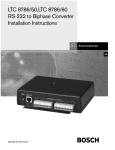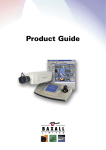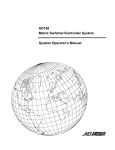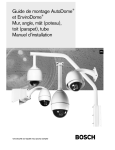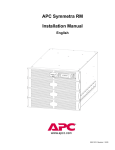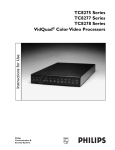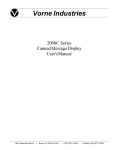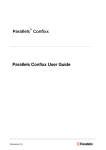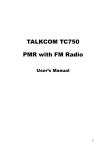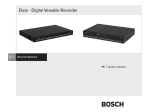Download Burley TC700 User's Manual
Transcript
AutoDome™ System TC700 Series Camera, Lens, Pan/Tilt, and Receiver/Driver Modules User’s Manual points or short-out parts that could result in a fire or electric shock. Never spill liquid of any kind on the unit. IMPORTANT SAFEGUARDS 16. Servicing - Do not attempt to service this unit yourself as opening or removing covers may expose you to dangerous voltage or other hazards. Refer all servicing to qualified service personnel. 1. Read Instructions - All the safety and operating instructions should be read before the unit is operated. 2. Retain Instructions - The safety and operating instructions should be retained for future reference. 17. Damage Requiring Service - Unplug the unit from the outlet and refer servicing to qualified service personnel under the following conditions: 3. Heed Warnings - All warnings on the unit and in the operating instructions should be adhered to. a. b. c. d. 4. Follow Instructions - All operating and use instructions should be followed. 5. Cleaning - Unplug the unit from the outlet before cleaning. Do not use liquid cleaners or aerosol cleaners. Use a damp cloth for cleaning. 6. Attachments - Do not use attachments not recommended by the product manufacturer as they may cause hazards. 7. Water and Moisture - Do not use this unit near water - for example, near a bath tub, wash bowl, kitchen sink, or laundry tub, in a wet basement, near a swimming pool, in an unprotected outdoor installation, or any area which is classified as a wet location. e. f. When the power-supply cord or plug is damaged. If liquid has been spilled, or objects have fallen into the unit. If the unit has been exposed to rain or water. If the unit does not operate normally by following the operating instructions. Adjust only those controls that are covered by the operating instructions, as an improper adjustment of other controls may result in damage and will often require extensive work by a qualified technician to restore the unit to its normal operation. If the unit has been dropped or the cabinet has been damaged. When the unit exhibits a distinct change in performance--this indicates a need for service. 18. Replacement Parts - When replacement parts are required, be sure the service technician has used replacement parts specified by the manufacturer or have the same characteristics as the original part. Unauthorized substitutions may result in fire, electric shock or other hazards. 8. Accessories - Do not place this unit on an unstable stand, tripod, bracket, or mount. The unit may fall, causing serious injury to a person and serious damage to the unit. Use only with a stand, tripod, bracket, or mount recommended by the manufacturer, or sold with the product. Any mounting of the unit should follow the manufacturer's instructions, and should use a mounting accessory recommended by the manufacturer. 19. Safety Check - Upon completion of any service or repairs to this unit, ask the service technician to perform safety checks to determine that the unit is in proper operating condition. An appliance and cart combination should be moved with care. Quick stops, excessive force, and uneven surfaces may cause the appliance and cart combination to overturn. 20. Coax Grounding - If an outside cable system is connected to the unit, be sure the cable system is grounded. U.S.A. models only-Section 810 of the National Electrical Code, ANSI/NFPA No.70-1981, provides information with respect to proper grounding of the mount and supporting structure, grounding of the coax to a discharge unit, size of grounding conductors, location of discharge unit, connection to grounding electrodes, and requirements for the grounding electrode. 9. Ventilation - Openings in the enclosure, if any, are provided for ventilation and to ensure reliable operation of the unit and to protect it from overheating. These openings must not be blocked or covered. This unit should not be placed in a built-in installation unless proper ventilation is provided or the manufacturer's instructions have been adhered to. 21. Lightning - For added protection of this unit during a lightning storm, or when it is left unattended and unused for long periods of time, unplug it from the wall outlet and disconnect the cable system. This will prevent damage to the unit due to lightning and power-line surges. 10. Power Sources - This unit should be operated only from the type of power source indicated on the marking label. If you are not sure of the type of power supply you plan to use, consult your appliance dealer or local power company. For units intended to operate from battery power, or other sources, refer to the operating instructions. FCC & ICES INFORMATION 11. Grounding or Polarization - This unit may be equipped with a polarized alternating-current line plug (a plug having one blade wider than the other). This plug will fit into the power outlet only one way. This is a safety feature. If you are unable to insert the plug fully into the outlet, try reversing the plug. If the plug should still fail to fit, contact your electrician to replace your obsolete outlet. Do not defeat the safety purpose of the polarized plug. (U.S.A. and Canadian Models Only) WARNING - This equipment has been tested and found to comply with the limits for a Class B digital device, pursuant to Part 15 of the FCC Rules and ICES-003 of Industry Canada. These limits are designed to provide reasonable protection against harmful interference when the equipment is operated in a residential installation. This equipment generates, uses and can radiate radio frequency energy and, if not installed and used in accordance with the instructions, may cause harmful interference to radio communications. However, there is no guarantee that interference will not occur in a particular installation. If this equipment does cause harmful interference to radio or television reception, which can be determined by turning the equipment off and on, the user is encouraged to try to correct the interference by one or more of the following measures: Alternately, this unit may be equipped with a 3-wire groundingtype plug, a plug having a third (grounding) pin. This plug will only fit into a grounding-type power outlet. This is a safety feature. If you are unable to insert the plug into the outlet, contact your electrician to replace your obsolete outlet. Do not defeat the safety purpose of the grounding-type plug. 12. Power-Cord Protection - Power-supply cords should be routed so that they are not likely to be walked on or pinched by items placed upon or against them, paying particular attention to cords and plugs, convenience receptacles, and the point where they exit from the appliance. - 13. Power Lines - An outdoor system should not be located in the vicinity of overhead power lines or other electric light or power circuits, or where it can fall into such power lines or circuits. When installing an outdoor system, extreme care should be taken to keep from touching such power lines or circuits as contact with them might be fatal. U.S.A. models only - refer to the National Electrical Code Article 820 regarding installation of CATV systems. - Reorient or relocate the receiving antenna. Increase the separation between the equipment and receiver. Connect the equipment into an outlet on a circuit different from that to which the receiver is connected. Consult the dealer or an experienced radio/TV technician for help. Intentional or unintentional changes or modifications not expressly approved by the party responsible for compliance shall not be made. Any such changes or modifications could void the user's authority to operate the equipment. The user may find the following booklet prepared by the Federal Communications Commission helpful: "How to Identify and Resolve Radio-TV Interference Problems". This booklet is available from the U.S. Government Printing Office, Washington, DC 20402, Stock No.004-000-00345-4. 14. Overloading - Do not overload outlets and extension cords as this can result in a risk of fire or electric shock. 15. Object and Liquid Entry - Never push objects of any kind into this unit through openings as they may touch dangerous voltage 2 Safety Precautions Securite CAUTION ATTENTION RISK OF ELECTRIC SHOCK. DO NOT OPEN! RISQUE DE CHOC ELECTRIQUE. NE PAS OUVRIR. CAUTION: TO REDUCE THE RISK OF ELECTRICAL SHOCK, DO NOT OPEN COVERS. NO USER SERVICEABLE PARTS INSIDE. REFER SERVICING TO QUALIFIED SERVICE PERSONNEL. Danger: Pour éviter tout risque d'électrocution, ne pas ouvrir le boîtier. Il n'y a pas de pièces remplaçables à l'intérieur. Pour toute révision, s'adresser à un technicien spécialisé. This label may appear on the bottom of the unit due to space limitations. Cet étiquette peut apparaître en dessous de l'appareil dû aux limitations d''espace. The lightning flash with an arrowhead symbol, within an equilateral triangle, is intended to alert the user to the presence of uninsulated "dangerous voltage" within the product's enclosure that may be of sufficient magnitude to constitute a risk of electric shock to persons. L'éclair fléché dans un triangle équilatéral avertit l'utilisateur de la présence d'une haute tension non isolée à l'intérieur de l'appareil. Elle peut être d'une magnitude suffisante pour constituer un risque d'électrocution. Le point d'exclamation à l'intérieur d'un triangle équilatéral avertit l'utilisateur de la présence d'instructions importantes d'utilisation et de maintenance dans la documentation accompagnant l'appareil. The exclamation point within an equilateral triangle is intended to alert the user to presence of important operating and maintenance (servicing) instructions in the literature accompanying the appliance. Attention Pour éviter un incendie ou une électrocution, ne pas exposer les appareils qui ne sont pas conçus spécifiquement pour usage extérieur à la pluie ou à l'humidité. Warning To prevent fire or shock hazard, do not expose units not specifically designed for outdoor use to rain or moisture. Attention: Installation should be performed by qualified service personnel only in accordance with the National Electrical Code or applicable local codes. Attention: L'installation doit être effectuée uniquement par du personnel de service qualifié conformément à la réglementation du Code Electrique National ou à la réglementation locale. Power Disconnect. Units with or without ON-OFF switches have power supplied to the unit whenever the power cord is inserted into the power source; however, the unit is operational only when the ON-OFF switch is in the ON position. The power cord is the main power disconnect for all units. Disjonction de l'alimentation. Les appareils avec ou sans commutateurs ON-OFF sont alimentés à chaque fois que le cordon d'alimentation est branché à la source d'alimentation; toutefois, les appareils disposant de commutateurs ON-OFF ne fonctionnnent que lorsque le commutateur ON-OFF est sur la position ON. Le cordon d'alimentation est la disjonction d'alimentation principale pour tous les appareils. External Power Supplies Use only the Recommended Power Supplies. Power supplies must comply with the requirements of the latest version of IEC 65/VDE 0860. Substitutions may damage the unit or cause a fire or shock hazard. Sources d'alimentation extérieures Utiliser uniquement les sources d'alimentation recommandées. Les sources d'alimentation doivent être conformes aux réglementations de la dernière version IEC 65/VDE 0860. Toute modification peut endommager l'appareil ou provoquer un incendie ou un choc électrique. 24 VAC Units Do Not Exceed 30 VAC Input. Voltage applied to the unit's power input should not exceed 30 VAC. Normal input voltage is 24 VAC. User supplied wiring from 24 VAC supply to unit must be in compliance with electrical codes (Class 2 power levels). Do not ground 24 VAC supply at power supply terminals or at unit's power supply terminals. Appareils 24 VCA Ne pas excéder 30 VCA. La tension appliquée à l'entrée d'alimentation de l'appareil ne devrait pas excéder 30 VCA. Toute installation électrique fournissant du 24 Volts courant alternatif doit être conforme aux codes électriques. (Niveaux d'alimentation de la Classe 2). Ne pas brancher une prise de terre sur les bornes d'alimentation 24 Volts ou aux bornes d'alimentation de l'appareil. 220-240 V, 50 Hz Power Cords 220-240 V, 50 Hz power cords, input and output, must comply with the latest versions of IEC Publication 227 or IEC Publication 245. Les cordons secteur 220-240 V, 50 Hz Les cordons secteur 220-240 V, 50 Hz, entrée et sortie, doivent êtro conformes aux versions les plus récentes de la publication 227 de la C.I.E. ou à la publication 245 de la C.I.E. 3 Sicherheitsvorkehrungen Precauciones de Seguridad VORSICHT PRECAUCION RISIKO EINES ELEKTRISCHEN SCHLAGES NICHT ÖFFNEN! R IESG O D E C HOQ U E ELEC TRICO . ¡N O ABRIR! VORSICHT: UM EINEN ELEKTRISCHEN SCHLAG ZU VERMEIDEN, ABDECKUNG NICHT ENTFERNEN. WARTUNGEN ALLER ART QUALIFIZIERTEM PERSONAL ÜBERLASSEN. Precaucion: Para Reducir El Riesgo De Choque Eléctrico, Favor No Abrir La Cubierta. Este Equipo No Consta De Piezas O Partes Que Requieren Servicio O Mantenimiento. Para Reparaciones Favor Referirse A Un Técnico Calificado. Aus Platzgründen kann diese Warnung auf der Unterseite des Gerätes angebracht sein. Debido a limitaciones de espacio, esta etiqueta puede aparecer en la parte inferior de la unidad. Das Blitzsymbol im gleichseitigen Dreieck soll den Benutzer auf nicht isolierte “Hochspannung” im Gehäuse aufmerksam machen, die eventuell stark genug ist, um einen elektrischen Schlag zu verursachen. El símbolo representado por un relámpago con punta de flecha dentro de un triángulo equilátero, se muestra con el objetivo de alertar al usuario que existen "voltages peligrosos" sin aislamiento, dentro de la cubierta de la unidad. Dichos voltages pueden ser de tal magnitud que constituyen un riesgo de choque eléctrico a personas. Das Ausrufezeichen im gleichseitigen Dreieck soll den Benutzer auf wichtige Bedienungs- und Wartungsanleitungen in der dem Gerät beigefügten Literatur aufmerksam machen. El símbolo de exclamación dentro de un triángulo equilátero, se muestra con el objetivo de alertar al ususario de que instrucciones de operación y mantenimiento importantes acompañan al equipo. Warnung Um Feuer oder elektrische Schläge zu vermeiden, setzen Sie das Gerät niemals Regen oder Feuchtigkeit aus. Peligro Para evitar el peligro de incendio ó choque eléctrico, no exponga a la lluvia ó humedad, equipos que no han sido diseñados para uso exterior. Achtung! Die Installation sollte nur von qualifiziertem Kundendienstpersonal gemäß jeweilig zutreffender Elektrovorschriften ausgeführt werden. Netzanschluß. Geräte mit oder ohne Netzschalter haben Spannung am Gerät anliegen, sobald der Netzstecker in die Steckdose gesteckt wird. Das Gerät ist jedoch nur betriebsbereit, wenn der Netzschalter (EIN/AUS) auf EIN steht. Wenn man das Netzkabel aus der Steckdose zieht, dann ist die Spannungszuführung zum Gerät vollkommen unterbrochen. Atención: La instalación de este equipo debe ser realizada por personal capacitado, solo en acuerdo, y en cumplimiento de normas del "National Electric Code" (Código Eléctrico Nacional) ó las normas del Gobierno Nacional Local. Para Desconectar la Alimentación: Unidades no equipadas con interruptores ON/OFF, son alimentadas cuando el cable de alimentación es conectado a la corriente eléctrica. Las unidades equipadas con interruptores son alimentadas de igual forma, pero adicionalmente requieren que el interruptor esté posicionado en ON. El cable de alimentación es el medio principal de desconexión del equipo. Externe Netzgeräte Nur vom Hersteller empfohlene Netzgeräte verwenden! Die Netzgeräte müssen der jeweils gültigen Version der IEC 65/VDE 0860 Bestimmungen entsprechen. Andere Ersatznetzgeräte können das vorliegende Gerät beschädigen und Feuer oder Elektroschlag bewirken. Fuentes de Alimentación Externas Usar solo las fuentes de alimentación recomendadas. Las fuentes de alimentación deben cumplir con los requisitos de la versión más reciente de la IEC 65/VDE 0860. El uso de substitutos puede dañar la unidad, ó crear peligro de incendio o choque eléctrico. 24 VAC Geräte Achtung! 30 Volt Eingangswechselspannung darf für 24 VAC Modelle nicht überschritten werden. Normalbetrieb findet bei 24 Volt Wechselspannung statt. Die Kabel- bzw. Drahtverbindung vom Netzgerät zu dem vorliegenden Gerät muß die Bestimmungen der Schutzklasse II erfüllen. Nicht die 24-Volt-Leitung erden weder am Netzgerät noch an den Anschlußklemmen des vorliegenden Gerätes. Unidades de 24 VCA No exceder 30 VCA de entrada. Voltage suplido a la unidad no debe exceder 30 VCA. Voltage de entrada normal es de 24 VCA. El cableado de 24 VCA provisto por el usuario debe cumplir con las normas eléctricas (Clase 2 de niveles de alimentación). No conectar los 24 VCA a tierra en las terminales de la alimentación ó a las terminales de la fuente de alimentación de la unidad. 220-240 V, 50 Hz Netzkabel, Eingang und Ausgang 220-240 V, 50 Hz Netzkabel, Eingang und Ausgang, muß die neueste Version der IEC Vorschriften, Veröffentlichung 227 oder 245, erfüllen. 220-240 V, los cables eléctricos de 50 Hz 220-240 V, los cables eléctricos de 50 Hz, de entrada y de salida, deben cumplir con las versiones mas recientes de la publicación IEC 227 ó la Publicación IEC 245. 4 TC700 Series - Camera, Lens, Pan/Tilt, and Receiver/Driver Modules Monochrome Models Model No. TC750-4-1 TC750-4-2 TC750-6-1 TC750-6-2 TC750-9-1 TC750-9-2 TC750X-4-1 TC750X-4-2 TC750X-6-1 TC750X-6-2 TC750X-9-1 TC750X-9-2 ATTENTION OBSERVE PRECAUTIONS FOR HANDLING ELECTROSTATIC SENSITIVE DEVICES WARNING: Electrostatic-sensitive device. Use proper CMOS/MOSFET handling precautions to avoid electrostatic discharge. NOTE: Grounded wrist straps must be worn and proper ESD safety precautions observed when handling the electrostatic-sensitive printed circuit boards. Sync System EIA RS-170 EIA RS-170 EIA RS-170 EIA RS-170 EIA RS-170 EIA RS-170 CCIR CCIR CCIR CCIR CCIR CCIR 1 Lens 4 to 40 mm 4 to 40 mm 5.8 to 58 mm 5.8 to 58 mm 8.7 to 87 mm 8.7 to 87 mm 4 to 40 mm 4 to 40 mm 5.8 to 58 mm 5.8 to 58 mm 8.7 to 87 mm 8.7 to 87 mm Receiver Allegiant biphase RS-232 Allegiant biphase RS-232 Allegiant biphase RS-232 Allegiant biphase RS-232 Allegiant biphase RS-232 Allegiant biphase RS-232 Color Models 1 Model No. Color System Lens Receiver TC770-4-1 NTSC 4 to 40 mm Allegiant biphase TC770-4-2 NTSC 4 to 40 mm RS-232 TC770-6-1 NTSC 5.8 to 58 mm Allegiant biphase TC770-6-2 NTSC 5.8 to 58 mm RS-232 TC770-9-1 NTSC 8.7 to 87 mm Allegiant biphase TC770-9-2 NTSC 8.7 to 87 mm RS-232 TC770X-4-1 PAL B 4 to 40 mm Allegiant biphase TC770X-4-2 PAL B 4 to 40 mm RS-232 TC770X-6-1 PAL B 5.8 to 58 mm Allegiant biphase TC770X-6-2 PAL B 5.8 to 58 mm RS-232 TC770X-9-1 PAL B 8.7 to 87 mm Allegiant biphase TC770X-9-2 PAL B 8.7 to 87 mm RS-232 TC790-4-1 NTSC 4 to 40 mm Allegiant biphase TC790-4-2 NTSC 4 to 40 mm RS-232 TC790-6-1 NTSC 5.8 to 58 mm Allegiant biphase TC790-6-2 NTSC 5.8 to 58 mm RS-232 TC790-9-1 NTSC 8.7 to 87 mm Allegiant biphase TC790-9-2 NTSC 8.7 to 87 mm RS-232 TC790X-4-1 PAL B 4 to 40 mm Allegiant biphase TC790X-4-2 PAL B 4 to 40 mm RS-232 TC790X-6-1 PAL B 5.8 to 58 mm Allegiant biphase TC790X-6-2 PAL B 5.8 to 58 mm RS-232 TC790X-9-1 PAL B 8.7 to 87 mm Allegiant biphase TC790X-9-2 PAL B 8.7 to 87 mm RS-232 1. All models include a 1/3-inch, f/1.8, 10X auto-iris zoom lens with auto-focus and pre-position with specified focal length. CONTENTS UNPACKING .................................................................. 5 TC700 Series - Camera, Lens, Pan/Tilt, and Receiver/Driver Modules...................................... 5 SERVICE........................................................................ 5 DESCRIPTION ............................................................... 6 INSTALLATION.............................................................. 6 Removing Module From Carton ................................ 6 OPERATION .................................................................. 6 Camera Control......................................................... 6 Changing Operating Modes ...................................... 6 AutoDome Commands.............................................. 6 DIP Switches ............................................................. 8 Thumbwheel Switch .................................................. 8 Camera Commands .................................................. 8 ILLUSTRATIONS ......................................................... 11 UNPACKING SERVICE Unpack carefully. This is electro-mechanical equipment and should be handled carefully. See INSTALLATION for additional unpacking instructions. If the unit ever needs repair service, the customer should contact the nearest Philips Communication & Security Systems Inc. Service Center for authorization to return and shipping instructions. Check for the following items: TC700 Series: Camera, lens, pan/tilt, and receiver/driver. See TC700 Series - Camera, Lens, Pan/Tilt, and Receiver/Driver Modules for model numbers. Service Centers U.S.A. & Canada: 800-366-2283 Mexico & Central America: 52-5-688-1466 Europe & Middle East: 44-1932-765666 South America: 54-1-956-0837 Australia: 61-2-888-9000 New Zealand: 64-4-237-7297 If an item appears to have been damaged in shipment, replace it properly in its carton and notify the shipper. If any items are missing, notify your Philips Communication & Security Systems Inc. Sales Representative or Customer Service. The shipping carton is the safest container in which the unit may be transported. Save it for possible future use 5 DESCRIPTION OPERATION The TC700 Series AutoDome™ systems are quiet, lightweight, and discreet surveillance dome systems containing high sensitivity 1/3-inch image format full performance monochrome or color CCD cameras with a 10:1 auto-iris, auto-focus zoom lens, a high-speed pan/tilt, and an intelligent, integral receiver/driver. The one-piece camera, lens, pan/tilt, and receiver/driver module is housed in a domed enclosure. They are available in suspended ceiling, hard ceiling recessed, surface, and pendant mount models. Pendant mount models are available for indoor or outdoor applications. Camera Control These units, as shipped, are factory adjusted as described below: Line-lock mode enabled with zero degree phase delay. AGC on. Backlight compensation off. Electronic shutter off. Automatic white balance on (color cameras only). Changing Operating Modes The AutoDome unit operating modes can be changed using either a TC8135B Series Controller/Follower or an Allegiant series keyboard. An Allegiant series keyboard is required to take full advantage of all the various features available. See Camera Commands for description of various camera operating adjustments. INSTALLATION Attention: Installation should be performed by qualified service personnel only in accordance with the National Electrical Code or applicable local codes. AutoDome Commands Attention: L'installation doit être effectuée uniquement par du personnel de service qualifié conformément à la réglementation du Code Electrique National ou à la réglementation locale. Receiver/Driver - Using Auxiliary Controls Achtung! Die Installation sollte nur von qualifiziertem Kundendienstpersonal gemäß jeweilig zutreffender Elektrovorschriften ausgeführt werden. Atención: La instalación de este equipo debe ser realizada por personal capacitado, solo en acuerdo, y en cumplimiento de normas del "National Electric Code" (Código Eléctrico Nacional) ó las normas del Gobierno Nacional Local. Receiver/Driver Function Aux No. Description On/Off Notes Scan 1 On/off 5 Auto-Pan 2 On/off -- Pre-Position Tour Set Scan/auto-pan speed Set tour period 8 14 Auto-pan without limits Auto-pan between limits --- On/off Inc/dec -2 2 Auto-Speed 16 Sets pause between Inc/dec tour callups Enables/disables On/off auto-speed 15 2 Lens - Using Auxiliary Controls Removing Module From Carton Lens Function Aux No. Description On/Off Notes Iris Control 3 -- 1 Focus Control 4 -- Auto-iris ALC adj Auto-iris Level adj Auto-focus Activation Auto-iris Activation 10 11 12 --Activates AF upon movement Activates AI upon movement Auto/ manual Auto/ manual Peak/ave Inc/dec On/off 1 1 2 On/off 2 Refer to ILLUSTRATIONS for component description. CAUTION: Keep in foil bag until grounded at unit. Be sure to observe all safety measures for static control when working with this unit while out of its enclosure. Otherwise, static damage may result. For removal from foil bag and installation instructions, see TC700 Series - Camera, Lens, Pan/Tilt, and Receiver/Driver Modules Installation under INSTALLATION in the Installation and Operating Instructions supplied with the particular Backbox Module ordered. 13 1 Auto-Speed (AUX 16) Auto-speed On: Issuing this command provides variable pan speed when unit is operated from a fixed speed location. The pan speed starts slowly and increases as the pan control is held on. The speed resets to slow when the pan control is released. Note: DIP Switch S2005.4 must be in the OFF position to use this command; see DIP Switch Settings in the applicable Installation and Operating Instructions for additional information. CAUTION: Do not handle the unit by the circuit board because this may result in physical damage to the unit. 6 Notes: 1. The following settings are stored with pre-position scenes: Pan position. Tilt position. Zoom position. Focus mode AUTO/MANUAL. Focus position for MANUAL mode. Iris mode AUTO/MANUAL. Iris ALC/LEVEL for AUTO mode or position for MANUAL mode. White Balance mode AUTO/MANUAL (color cameras only). Red content and Blue content for MANUAL mode (color cameras only). Shutter mode ON/OFF. Shutter setting for ON mode. Backlight compensation ON/OFF. Highlight ON/OFF (monochrome cameras only). Camera - Using Auxiliary Controls Camera Function Aux No. Description On/Off Notes BL_COMP 20 Backlight Compensation On/off 1 HIGH-LIGHT 21 Highlight On/off 1, 7 SHUTTER_ADJ 22 Shutter Adjust Inc/dec 1 SHUTTER 23 Shutter On/off 1 WHITE_BALANCE 30 White Balance Auto/ manual 8 RED 31 Red Adjust Inc/dec 1, 8 BLUE 32 Blue Adjust Inc/dec 1, 8 R_Y_HUE 33 R-Y Hue Adjust Inc/dec 3, 8 B_Y_HUE 34 B-Y Hue Adjust Inc/dec 3, 8 FIXED_WB 35 Fixed White Balance Indoor/out 1, 8 door FACTORY_ DEFAULTS 40 Factory Default Settings Set/--- 1,3 LL_PHASE 41 Adjust LL Phase Delay Inc/dec 3 SYNC 42 Sync Mode ll/xtal 3 AGC 43 AGC On/off 3 Auto-iris and auto-focus revert to manual mode when the manual iris and focus controls are used, respectively. 2. The following settings are stored as a default setting in nonvolatile memory (EEPROM) on R/D board and are used to restore settings at power-up: Auto-pan left limit = 0 degrees. Auto-pan right limit = 359.9 degrees. Auto-pan speed = 30 degrees per second. Auto-focus activation = ON. Auto-iris activation = ON. Auto-speed = OFF. Switching to manual iris or manual focus from auto mode reverts to the last manual setting used. 3. This setting stored as a default setting in nonvolatile memory in camera. Auto-focus is activated automatically upon pan or tilt when Auto-focus Activation is on (AUX #12). 4. Pre-position #1 (if set) is automatically called-up upon power-up just after the homing sequence. Manual iris is activated automatically upon activating (ON) Backlight Compensation. 5. Scan direction determined by last manual pan direction. Commands Using Pre-Position Controls 6. Pre-positions can be disabled such that they do not operate during pre-position tour. They are still available for manual call-up. Note: Auto-pan is discontinued when the manual pan control (joystick) is used. Receiver/Driver Function PrePosition No. Description SET/SHOT Notes Pre-position 1-60 --- Set/show 4 Future PP Expansion 61-100 --- ----/---- -- Auto-pan left limit 101 --- Set/show 2 Auto-pan right limit 102 --- Set/show 2 Home Position 110 --- Recalibrate/ show -- Recording Playback: 1. Position AutoDome to the point where playback is to start. Disable/Enable PP 901-960 --- Disable/ enable 6 2. Press On, AUX 100, ENTER. Global Disable/ Enable PP 900 --- Disable/ enable 6 3. Begin controlling the AutoDome. 7. Applies to monochrome cameras only. 8. Applies to color cameras only. Auto-Playback Applicable only to units fitted with this feature. 4. At the completion of controlling the AutoDome, press Off, AUX 100, ENTER. Note: If you run out of record time prior to issuing the stop record command, the AutoDome will position itself at the beginning and not move until the joystick is released for one second. 7 Executing Playback: 1. Press ON, AUX 50, ENTER for continuous playback. DIP Switch Settings 1 2 3 Off Off Off On Off Off Off On Off On On Off Off Off On On Off On Off On On On On On 2. Press ON, AUX 51, ENTER for single playback. Stopping Playback: 1. Press Off, AUX 50 or AUX 51, ENTER or move joystick. Resuming Playback After Stopping During Playback: 1. After stopping during playback, press On, AUX 52, ENTER. Maximum Speed (°/s) 4 6 10 15 20 30 45 60 If the auto-speed feature is enabled (see DIP switch S2005.4), these DIP switches apply only to the tilt speed. Note: If you have moved the AutoDome since stopping, playback will resume where playback was previously stopped. S2005.4: This switch controls the Auto-speed feature. When on, auto-speed is always enabled and control by AUX 16 is ignored; see Auto-Speed (AUX 16) under SETUP & MAINTENANCE in TC700 Series Camera, Lens, Pan/Tilt, and Receiver/Driver Modules User’s Manual (TC700-UM) for description. When auto-speed is enabled, the pan speed starts out slowly and increases as the pan control is held on. The speed resets to slow when the pan control is released. The tilt speed is not affected by this switch. It is still controlled by the setting determined by DIP switches S2005.1, S2005.2, and S2005.3. The auto-speed feature is only applicable when the dome is being controlled by a system generating “fixed speed” commands. Adding To Previously Recorded Playback: 1. Execute a single playback. 2. Wait for the playback to end. 3. Press On, AUX 101, ENTER. 4. Begin controlling the AutoDome. 5. At the completion of controlling the AutoDome, press Off, AUX 100 or AUX 101, ENTER. Changing Ending of Previously Recorded Playback: 1. Execute a single playback. 2. Wait for the playback to reach the point where the change is desired. S2006.1: RS-232 Baud rate: 2400 - OFF, 9600 - ON S2006.2: Lens Zoom Polarity S2006.3: Lens Focus Polarity S2006.4: Lens Iris Polarity S2007.1: Not defined, set to OFF S2007.2: Not defined, set to OFF S2007.3: Not defined, set to OFF S2007.4: Not defined, set to OFF S2008.1: Reserved, set to OFF S2008.2: Reserved, set to OFF S2008.3: Reserved, set to OFF S2008.4: Not defined, set to OFF 3. Press Off, AUX 50 or AUX 51, ENTER to stop playback. This step is optional. 4. Press On, AUX 101, ENTER 5. Begin controlling the AutoDome. 6. At the completion of controlling the AutoDome, press Off, AUX 100 or AUX 101, ENTER. Erasing A Playback From Some Point In Playback To The End: 1. Execute a single playback. 2. Wait for the playback to reach the new stopping position. Thumbwheel Switch 3. Press Off, AUX 50 or AUX 51, ENTER. As Address selector, 0000 responds to all messages regardless of address; otherwise the unit will only respond to commands issued for that address. 4. Press Set, AUX 500, ENTER. DIP Switches Camera Commands S2005.1, S2005.2, and S2005.3: These DIP switches are used to set both the pan and tilt speeds when the dome is being controlled by a system generating "fixedspeed" commands. The table below lists the maximum speeds when the zoom lens is set for full wide angle. The speed automatically decreases from the maximum speed as the lens is adjusted towards the telephoto settings. At its full telephoto setting, the speed will be decreased to approximately 12% of its full wide angle speed. Adjustable Phase Vertical Line Lock (AUX 41) In multicamera systems using vertical interval switchers, it is desirable to have the video output signals from all cameras vertically synchronized. To achieve synchronization, it may be necessary to generate phase delays in some cameras, especially if the cameras receive power from different phases of a 3-phase power source. As shipped from the factory, camera vertical sync is aligned with the positive-going zero crossing of the hot 8 side of the AC power input to the dome. This is the "zero phase delay" position. The phase delay between the AC line zero crossing and camera vertical sync can range to 360 degrees, with respect to the original "zero phase" position. The 360 degree range is divided into 362 steps for NTSC cameras and 370 steps for PAL cameras, so that very fine adjustment of the phase delay is possible. Backlight Compensation Off: Issuing this command disables the camera's backlight compensation mode. (AUX 20 - Off.) Increase Phase Delay: Issuing this command increases the line-lock phase delay by one step. (AUX 41 - On.) Decrease Phase Delay: Issuing this command decreases the line-lock phase delay by one step. The phase delay commands have no effect when the camera is in the internal crystal sync mode. (AUX 41 - Off.) S929A64BE Backlit Condition Backlight Compensation OFF Sync Mode Selection (AUX 42) Line-Lock Mode On: Issuing this command puts the camera into the line-lock sync mode. The phase delay will be at the most recently set position. (AUX 42 - On.) Backlight Compensation On: Issuing this command enables the camera's backlight compensation mode. (AUX 20 - On.) Internal Crystal Mode On: Issuing this command puts the camera into the internal crystal sync mode. In this mode, the camera's vertical sync has no fixed relationship to the AC power line. The vertical rate is 59.94 Hz for NTSC cameras and 50 Hz for PAL cameras. (In line-lock mode, the vertical rate is 60 Hz for NTSC cameras and 50 Hz for PAL cameras.) (AUX 42 - Off.) AGC Mode Selection (AUX 43) S929A66AE The camera includes an AGC circuit that automatically increases camera sensitivity at low levels of illumination. Backlit Condition Backlight Compensation ON AGC On: Issuing this command turns the camera AGC on. The AGC operates with its maximum range of 30 dB. (AUX 43 - On.) AGC Off: Issuing this command turns the camera AGC off. The AGC operates with a fixed gain of 5 dB, resulting in a loss of camera sensitivity, but improving the signalto-noise ratio. (AUX 43 - Off.) line 80 line 200 Backlight Compensation (AUX 20) Normally, the camera AGC averages the contents of the entire field-of-view to determine the best AGC operating point. If the field-of-view contains large brightly lit background areas and a small dimly lit foreground object, the camera AGC may select an operating point that does not allow for adequate viewing of the foreground object. The AutoDome series cameras have a fixed zone backlight compensation mode to alleviate this problem. With backlight compensation turned on, the camera determines its AGC operating point by averaging over a subset of the entire field-of-view, as shown in the figure below. (Camera AGC must be ON for the backlight compensation to function.) If the object of interest falls inside this zone, its visibility will remain relatively constant even if the background illumination varies. To achieve the best picture quality, under most lighting conditions, turn off the backlight compensation. Use this mode only to specifically compensate for a backlit condition. S929A65AE Zone of AGC Operation With Backlight Compensation ON Highlight (AUX 21) Highlight On: Issuing this command turns on the highlight mode. This mode is an alternative method for compensating a field-of-view that contains a brightly lit background and a dimly lit foreground object. With highlight mode turned on, a fixed center zone will appear on the screen having a gain of approximately 10 dB higher than the operating point determined by the AGC. The camera continues to average the contents of the entire field-of-view to determine the best operating point. The advantage of using this mode is that the area surrounding the lit object will not white-wash. Only objects in the center zone will be amplified. This mode could also help target the backlight compensation zone 9 since both zones are the same. A dome operator can see where the backlight compensation zone will average in the field-of-view. Manual White Balance - Increase Red: Issuing this command increases the red content of the picture by one step. (AUX 31 - On.) Electronic Shutter (AUX 22, 23) Manual White Balance - Decrease Red: Issuing this command decreases the red content of the picture by one step. (AUX 31 - Off.) The camera's electronic shutter covers a range of 1/60 second (1/50 second for PAL units) to 1/10,000 second in 261 steps (311 steps for PAL units). As the electronic shutter speed increases, the time allowed during each video field for light to collect on the CCD decreases, resulting in a loss of sensitivity. However, higher shutter speeds tend to produce a "stop action" effect on moving images, greatly increasing the camera's dynamic resolution. Manual White Balance - Increase Blue: Issuing this command increases the blue content of the picture by one step. (AUX 32 - On.) Manual White Balance - Decrease Blue: Issuing this command decreases the blue content of the picture by one step. (AUX 32 - Off.) Fixed 3200 K White Balance On: Issuing this command turns off the automatic mode, and sets the white balance to approximately 3200 K. (AUX 35 - On.) Increase Electronic Shutter Speed: Issuing this command will turn on the electronic shutter, and increase the shutter speed by one step. (AUX 22 - On.) Fixed 5500 K White Balance On: Issuing this command turns off the automatic mode, and sets the white balance to approximately 5500 K. (AUX 35 - Off.) Decrease Electronic Shutter Speed: Issuing this command will turn on the electronic shutter, and decrease the shutter speed by one step. (AUX 22 - Off.) Hue Adjustment (AUX 33, 34) Electronic Shutter Off: Issuing this command will disable the camera's electronic shutter. (AUX 23 - Off.) For most applications it is not necessary to make any hue adjustments to the camera. If you do need to make hue adjustments, be aware that by improving the color rendition of one hue, you are probably degrading the color rendition of some other hue. Depending on the trade-offs required by each application, this may or may not be acceptable. Electronic Shutter On: Issuing this command will turn on the camera's electronic shutter. The shutter speed will be at the last set position. (AUX 23 - On.) White Balance (AUX 30, 31, 32, 35) Auto White Balance On: Issuing this command turns on the automatic white balance. The white balance setting adjusts continuously as the color temperature of the scene changes. This mode is recommended for situations where the color temperature of the scene varies during shooting. Continuous white balancing may not produce optimum color rendition when little or no white is present in the scene. (AUX 30 - On.) R-Y Hue Increase: Issuing this command will shift red hues toward magenta by one step. (AUX 33 - On.) R-Y Hue Decrease: Issuing this command will shift red hues toward yellow by one step. (AUX 33 - Off.) B-Y Hue Increase: Issuing this command will shift blue hues toward cyan by one step. (AUX 34 - On.) B-Y Hue Decrease: Issuing this command will shift blue hues toward magenta by one step. (AUX 34 - Off.) Perform "Push Button" White Balance: Take the following steps to perform a "push button" white balance: Factory Default (AUX 40) 1. Aim the camera at a white object, such as a white wall or a piece of paper. The white object should fill the entire field of view of the camera. The camera can always be returned to its original state, as shipped from the factory. (AUX 40 - On.) Factory Defaults: Issuing this command will reset the camera hues to their factory adjusted values, turn on the AGC and the auto white balance, turn off the electronic shutter and the backlight compensation, and put the camera in line-lock mode with a phase delay of zero degrees. 2. Issue the command (AUX 30 - Off.). The picture should turn white within a few seconds. Continuous automatic white balancing is now disabled. Turning on the manual white balance disables the automatic white balance. There are 107 steps of adjustment for changing either the red or blue content of the picture. 10 ILLUSTRATIONS Site Address Thumbwheel DIP Switches Remove Screw & Shipping Bracket Prior to Operation Tilt Motor Remove Foam Prior To Operation Connector S9407002AE TC700 Series - Camera, Lens, Pan/Tilt, and Receiver/Driver Module 11 Patented under U.S. Patent No. 5,517,236 ALL SPECIFICATIONS SUBJECT TO CHANGE WITHOUT NOTICE. INFORMATION FURNISHED BY PHILIPS COMMUNICATION & SECURITY SYSTEMS INC. (PCSS) IS BELIEVED TO BE ACCURATE AND RELIABLE. HOWEVER, NO RESPONSIBILITY OR LIABILITY IS ASSUMED BY PCSS FOR ITS USE, NOR FOR ANY INFRINGEMENT OF PATENTS OR OTHER RIGHTS OF THIRD PARTIES WHICH MAY RESULT FROM ITS USE. NO LICENSE IS GRANTED BY IMPLICATION OR OTHERWISE UNDER ANY PATENT OR OTHER RIGHTS OF PCSS. © 1994, 1995, 1996 by Philips Communication & Security Systems Inc. All Right Reserved. BURLE ® is a registered trademark of BURLE TECHNOLOGIES, INC. Marca(s) Registrada(s). Philips Communication & Security Systems Inc., 1004 New Holland Avenue, Lancaster, PA 17601-5606, USA Tel: 1-717-295-6123 Fax: 1-717-295-6097 Philips Communication & Security Systems Inc., 750 Vista Blvd., Suite 403, Sparks, NV 89434, USA Tel: 1-702-331-4155 Fax: 1-702-331-2306 Philips Communication & Security Systems Inc., Access Control Hardware, 7041 Orchard, Dearborn, MI 48126-1781, USA Tel: 1-313-846-2623 Fax: 1-313-846-3569 Philips Electronics UK Ltd., Windmill Court, Brooklands Close, Sunbury-on-Thames, Middlesex TW16 7DX, England, U.K. Tel: 44-1932-765666 Fax: 44-1932-783198 n.v. Philips Professional Systems s.a., Monnikenwerve 17-19, B-8000 Brugge, Belgium Tel: 32-50-454670 Fax: 32-50-454544 Philips Singapore Pte Ltd., 7500A Beach Road, #04-324 The Plaza, Singapore 199591, Republic of Singapore Tel: 65-293-0555 Fax: 65-293-7238 Printed in U.S.A./JUL96 TC700-UM00












